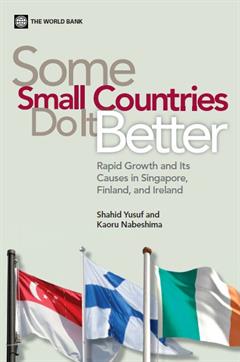
At the launch, Dr Luis Benveniste, Sector Manager for Education in East Asia and Pacific at the World Bank will introduce the book, and Dr Shahid Yusuf, Economic Adviser and Dr Kaoru Nabeshima, Director of Technological Innovation and Economic Growth Studies Group, Institute of Developing Economies will present key findings from their book. Professor Tommy Koh Ambassador-At-Large at the Ministry of Foreign Affairs and Special Adviser of the Institute of Policy Studies and Chairman of the Centre for International Law, National University of Singapore will moderate a panel; discussion with the following panelists:
• Mr Bert Hofman, Country Director and Chief Economist for the East Asia and Pacific Region, The World Bank
• Dr Yaw Ansu, Chief Economist, Africa Center for Economic Transformation
• Mr Yeoh Lam Keong, Vice President, Economic Society of Singapore
• Mr Vikram Khanna, Associate Editor, Business Times, Singapore
This comparative study of three small economies was prepared following the authors’ visit to Singapore in 2009 in the company of African policy makers who were interested in learning about the contribution of institutions and human capital to successful economic development. Although originally intended to draw lessons for late-starting African economies, the book addresses issues that turn out to be highly relevant in other settings as well.
Virtually every country in the world today is struggling to raise or maintain its GDP growth rate with even the high flyers of yesteryear worrying about middle income traps. In casting around for new ‘growth’ recipes that are validated by demonstrated results, one is drawn to the experience of economies that relied less on the sheer volume of capital spending (or an abundance of natural resources) and more on other drivers of growth: human capital and knowledge. Finland and Ireland are among the tiny band of nations that grew rapidly for well over a decade by adopting an approach that derived the maximum mileage from an adequate investment in physical assets and by harnessing the potential of human capital and technologies. Singapore adopted a hybrid approach that embraces the high investment, export-led East Asian model, but by quickly moving to build its human and knowledge assets, the country was able to upgrade and diversify much faster into higher technology manufactures and tradable services than some of the other East Asian economies. Such diversification has enabled Singapore to maintain higher growth rates over a longer period. The path followed by these three countries offers a different perspective on growth. Their approach may be of greater relevance than the well-worn East Asian model in the highly competitive global environment of the early 21st century because it does not necessarily assume heroic levels of investment. Moreover, it may be better tailored to the opportunities available to a heterogeneous group of middle- and lower-middle-income economies aiming for growth rates in the 6 percent range, as well as to late-starting, low-income countries that, because of their youthful, rapidly increasing populations, need to grow at high single-digit rates to create enough jobs and to double per capita income in 10 years.
Media Coverage